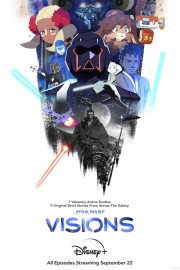Star Wars: Visions (TV)
One of the things long-term fans of “Star Wars” have in their brain is not just the knowledge that Lucas was inspired by Joseph Campbell’s ideas of hero archetypes in writing the initial trilogy, but that “The Hidden Fortress,” Akira Kurosawa’s 1958 samurai film, played a big part in the structure of “A New Hope.” The connection between “Star Wars” and samurai cinema was further accentuated in how “The Mandalorian” borrowed from the “Lone Wolf and Cub” series as Mando took Baby Yoda as someone to be protected. If you are a fan of “Star Wars,” and haven’t seen either of those influences, now would be a good time to check them out.
“Star Wars: Visions” is a series of nine short films, animated by Japanese filmmakers and animation houses. In many of their efforts, that blending of “Star Wars” and Japanese culture is as strong as it’s ever been. Naturally, when the project was first announced, the first thing I had in mind was “The Animatrix,” the nine-short film project the Wachowski sisters produced in the build-up to “The Matrix” sequels. If you asked me to compare the two, I think “The Animatrix” is a better experience in how it deepens the concepts of the films, but that doesn’t mean “Visions” is a slouch. One of the best things Lucasfilm did with this is to allow the filmmakers to not have to adhere to the canonical timeline of the Universe. The results are a mixed bag, but more importantly, one that has a little bit of something for everyone.
Take the second film of the nine, “Tattoine Rhapsody.” Now, if the updated number in Jabba’s palace in “Return of the Jedi” annoyed you, how about a contemporary rock band trying to break through, with one of Jabba’s progeny as one of the members? While that’s a bit annoying, I have been hoping recently to get more depth and flavor of music in the “Star Wars” Universe, and Taku Kimura’s short certainly delivers that. This is more goofy and kid friendly; I think a younger audience will enjoy it more than an old guy like me.
Another one that is clearly for a younger audience is Abel Gongora’s “T0-B1.” It’s about a young robot who dreams of being a Jedi, and his master, who gives him a quest. I really liked the animation in this film more than the story, but it captures some of that feeling the ending of “The Last Jedi” with the kid with the broom had. It’s a winner.
In “Akakiri” and “The Village Bride,” Eunyoung Choi and Hitoshi Haga, respectively, tell stories that feel more in the “inspired by Kurosawa but are adapted in the ‘Star Wars’ idiom” that we got off and on in “The Clone Wars” and “Rebels,” as peaceful individuals learn to rock the boat with Sith and the Empire. Both are strong in terms of animation, but “Bride” definitely had more of a cohesive narrative than “Akakiri.”
Siblings are on the opposite ends of the Force in “The Twins,” which starts with a brother and sister harnessing the power of a Kyber crystal for destructive purposes, and “Lop & Ocho,” where step sisters draw their respective lines when it comes to working with the Empire, or being with family. The animation styles of Hiroyuki Imaishi and Yuki Igarashi are rich and compelling, and both touch on strong familial themes, although “Lop & Ocho” captivates with the more rousing action and emotional drama.
In “The Ninth Jedi,” some remaining Jedi are given a message to meet on a planet where Kyber crystals are plentiful, but when they arrive, is it a trap? Kenji Kamiyama’s film is the longest of the bunch (it was originally two films), and it has some of my favorite animation, and maybe the most stripped down, but emotional, narrative of the bunch. It is a great finale.
What connected the most with me, however, about the films in the “Visions” anthology, is when filmmakers really leaned into not just the familiar visual styles of anime, but Japanese culture, and bringing it directly to the concepts and world of “Star Wars.” There’s a little bit of that in many of the films, but the two that leaned the most into it were Takanobu Mizuno’s “The Duel” and Masahiki Ôtsuka’s “The Elder.” The stories deal in familiar tropes and dramatic beats, but the way the directors animate the films, and seem to bring the world of “Star Wars” to ancient Japan, is what makes these stand above the rest for me, and show so much potential for a “Star Wars” capable to living beyond the canon we know, and being adapted into something personal, and thrilling. You know, kind of like what George Lucas did in the first place.










